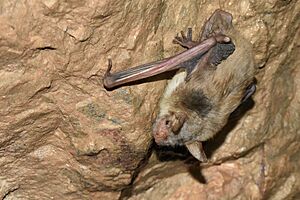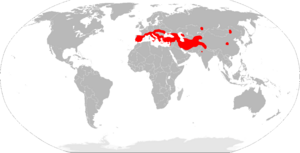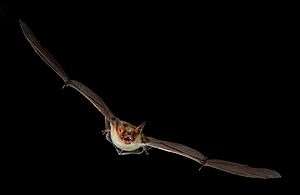Lesser mouse-eared bat facts for kids
Quick facts for kids Lesser mouse-eared bat |
|
|---|---|
 |
|
| Conservation status | |
| Scientific classification | |
| Genus: |
Myotis
|
| Species: |
blythii
|
 |
|
| Myotis blythii distribution | |
| Synonyms | |
|
|
The lesser mouse-eared bat (Myotis blythii) is a type of bat. It's also known as the lesser mouse-eared myotis. These bats are insectivores, meaning they mostly eat insects. They belong to a bat family called Vespertilionidae.
Contents
Where Lesser Mouse-Eared Bats Live
Lesser mouse-eared bats live in many different countries. You can find them across parts of Europe and Asia. Their range stretches from southern Europe all the way to the western Himalayas.
Countries Where They Are Found
These bats live in countries like Afghanistan, Albania, Austria, and Bangladesh. They are also found in Bulgaria, China, Croatia, and France. Other homes include Georgia, Germany, Greece, and Hungary. You can also spot them in India, Iran, Iraq, Israel, and Italy. Their habitat extends to Jordan, Kazakhstan, Lebanon, and Mongolia. They also live in Pakistan, Portugal, Romania, Russia, Slovenia, Cyprus, Spain, Switzerland, Syria, Turkmenistan, and Ukraine.
Challenges for Lesser Mouse-Eared Bats
The number of lesser mouse-eared bats is going down. This is mainly because of pollution and changes in how land is used.
Impact of Human Activities
Loud sounds from construction can bother these bats. For example, in southern Spain, the bat population in Andalusia dropped a lot. It went from 30,000 bats in 1994 to 14,000 by 2002. Also, in places like Syria and Turkey, people sometimes make fires near cave entrances. This can disturb the bats living inside the caves.
Protecting Lesser Mouse-Eared Bats
Many efforts are being made to protect these bats. They are important for our environment.
Conservation Efforts in Europe
Most of Europe protects the lesser mouse-eared bat. This is done through agreements like the Bonn Convention and the Berne Convention on the Conservation of European Wildlife and Natural Habitats. These agreements help keep wildlife safe.
Special Protected Areas
The bats need special places to live and breed. These are called Special Areas for Conservation. The Natura 2000 network also helps protect these bats. In some European countries, fences are put up around caves. This stops visitors from disturbing the bats inside.
Characteristics of Lesser Mouse-Eared Bats
These bats are quite large for a bat. They have some interesting features.
Size and Weight
Lesser mouse-eared bats are usually about 62–70 millimetres (2.4–2.8 in) (about 2.4 to 2.8 inches) long. They are also quite light. An adult bat typically weighs around 16–26 grams (0.56–0.92 oz) (about 0.5 to 0.9 ounces).



